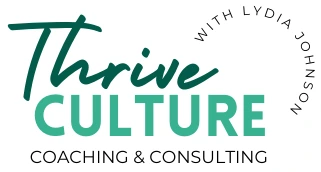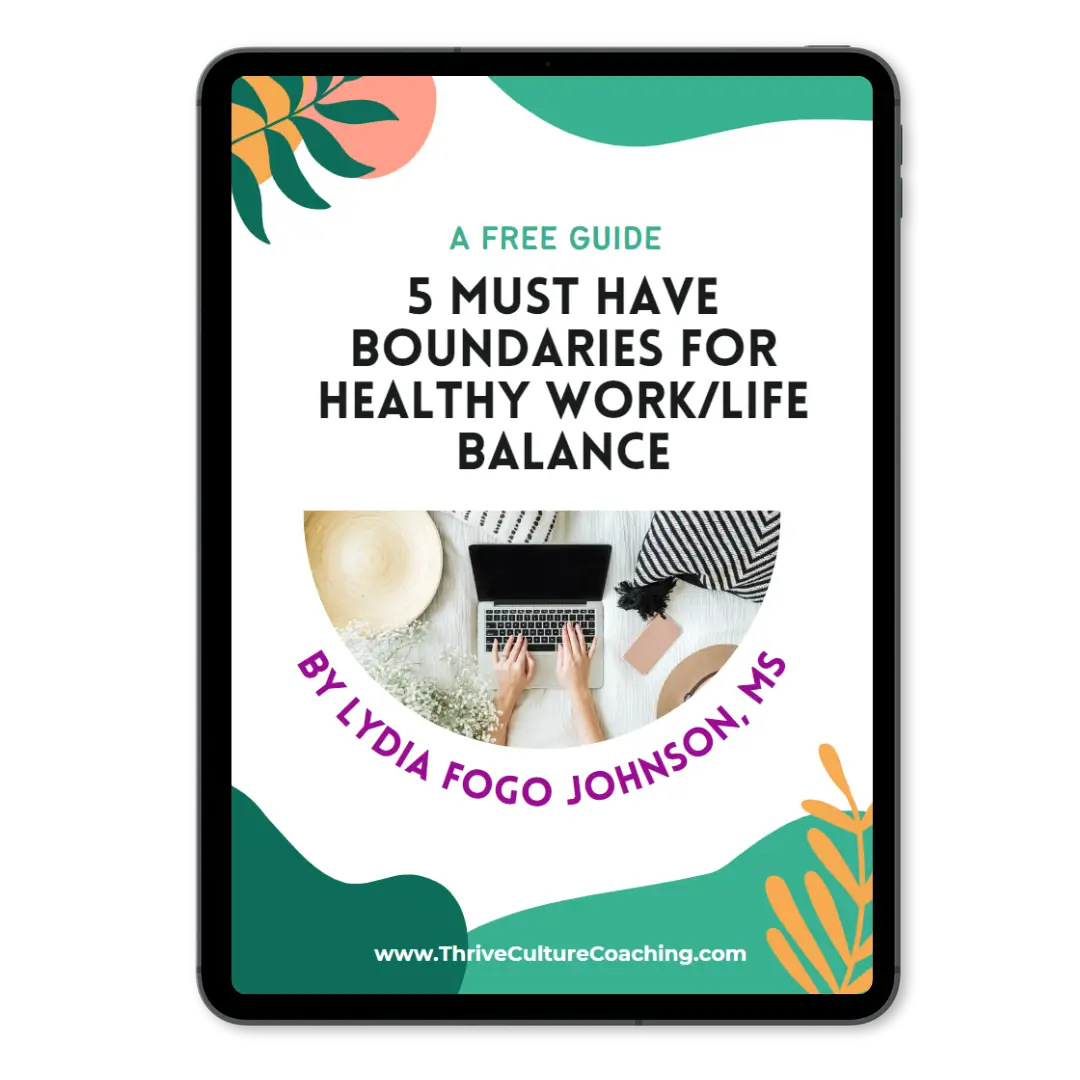Table of Contents
You’re tired. Not just “end-of-a-long-day” tired, but a deep, bone-weary exhaustion that follows you around constantly.
Your energy is at an all-time low, and just getting through the workday feels like a monumental effort.
If this sounds all too familiar, it might be time to ask yourself a critical question: “Am I dealing with simple fatigue, or is this something more serious, like burnout?”
My name is Lydia Fogo Johnson, MS, and as a burnout coach, this is one of the most common and important questions I explore with my clients.
People often use these terms interchangeably, but they are not the same. Understanding the difference is the first crucial step toward finding the right path to healing.
This guide will walk you through the distinctions in simple terms. We’ll explore the signs, causes, and proven ways to recover, so you can identify what you’re facing and start reclaiming your well-being.
What is Fatigue? The Body’s Low-Battery Warning
Fatigue isn’t just feeling tired. It’s a whole-body signal that something deeper is off—your body’s version of a low-battery warning that you can’t ignore.
Unlike typical tiredness that a nap or coffee might fix, fatigue is a lingering heaviness that affects both your physical energy and mental clarity. It can show up as persistent drowsiness, a foggy brain, or a sense that even the simplest tasks require too much effort.
And the causes? They’re often rooted in physical or personal factors, compared to burnout’s work-related causes.
Fatigue can stem from:
- Sleep issues, including disrupted sleep, insomnia, or sleep apnea
- Nutritional deficiencies, like low iron or B12
- Hormonal changes, such as perimenopause or thyroid issues
- Chronic illness, autoimmune disorders, or post-viral symptoms
- Intense physical exertion or overtraining
- Mental health struggles, such as depression or anxiety
- Life stage demands, including the intense caregiving years of parenting
Special Call‑Out for Working Moms
If you’re a working mom, fatigue can feel like your constant companion. Between broken nights, early mornings, and the nonstop demands of both work and home, deep rest is hard to come by. Many of my clients are running on years of sleep debt—especially in those early parenting stages when true recovery time just doesn’t exist. If that’s you, know this: your exhaustion is real, and you’re not imagining it. If your fatigue may be caused by your children’s nighttime struggles, it may be time to enlist the support of a family sleep specialist. I certainly leveraged this when my son was younger!
But here’s the good news
Once you address the root cause—whether that’s a sleep issue, health condition, or schedule strain—your body often recovers faster than you’d expect. Fatigue tends to respond well to small, intentional shifts: sleep hygiene, nutrition tweaks, or support from your primary care physician.
Ask yourself:
Do any of these fatigue sources feel familiar?
If so, consider reaching out for help—whether a doctor, nutritionist, hormone specialist, or even a sleep consultant for your little one—to begin resolving the root causes.
What is Burnout?
Burnout, on the other hand, is much deeper and more complex. Unlike fatigue, which usually has a clear physical cause and often can be fixed with additional sleep or addressing health challenges, burnout stems from a combination of chronic stressors that require a far more comprehensive, long-term recovery plan.
Common culprits include:
- An unmanageable workload or work schedules
- A lack of control and autonomy
- Inadequate resources and training to meet your demands
- A breakdown in the workplace relationships and communication
- A mismatch between your values and your daily work
The World Health Organization’s International Classification of Diseases (ICD-11) describes burnout as “a syndrome resulting from chronic workplace stress that has not been successfully managed.” Recognizing burnout as a syndrome is especially important because it helps ease the stigma and self-blame that so often weigh heavily on those affected.
When burnout is seen as a legitimate health condition caused by ongoing, unmanaged stress—not a personal flaw or weakness—it shifts the narrative. Instead of blaming yourself for “not being strong enough” or “not managing well,” you begin to understand that your experience is a natural response to difficult circumstances.
This awareness can reduce feelings of guilt and isolation, making it easier to seek help and embrace the patient, compassionate approach needed to recover and rebuild your energy and sense of purpose.
To make it easier to spot burnout in your own life, the WHO highlights three main ways it may show up:
1. Chronic Exhaustion
This isn’t your average afternoon slump — it’s a persistent, bone-deep exhaustion that doesn’t lift with a good night’s sleep or even a weekend away.
Some of my clients describe it as feeling “worn out and weary” after work, “exhausted before the day even begins,” or never having enough energy left for family or friends. Others have called it “running on fumes” or feeling like their work “consumes everything I’ve got” to the point where there’s “nothing left.”
2. Cynicism & Negativity
Burnout can also show up as a shift in how you feel about your work — and sometimes the people around you. You might find yourself rolling your eyes at meetings, doubting the significance of what you do, or feeling disconnected from your coworkers, clients, or company.
Things that once barely registered as annoyances now feel like evidence of everything that’s wrong. As one client put it, “I just don’t have it in me to care anymore.”
3. Reduced Professional Efficacy
The third sign is quieter but just as damaging: a creeping sense that you’re less capable or effective in your role. You may battle imposter syndrome, question the value of your contributions, or notice your productivity slipping. Even tasks that once felt effortless can start to feel heavy and unmanageable.
This means that if you are experiencing low self-confidence right now, it’s a major signal that you might be experiencing burnout and not just fatigue. All too often, clients don’t realize that low confidence is part of their burnout and not just a side effect.
Understanding the Types of Burnout: Which One Feels Like You?
Burnout doesn’t look the same for everyone. Figuring out which kind you’re dealing with is key to knowing whether you’re truly burnt out or just plain tired. And once you know, it’s much easier to take the right steps to turn things around.
Here’s how the main types of burnout play out—and how to spot them in yourself.
Overload Burnout
This happens when your workload is overwhelming and never-ending. You’re constantly racing against deadlines, skipping breaks, and running on empty. Physically and mentally, you feel drained and stuck in a cycle of pushing yourself without enough time to recharge.
The best way to heal this type? Lighten your load. This could be through delegating, setting boundaries, or taking time off. But when you’re drowning in deadlines, even imagining that kind of change can feel impossible.
But it shouldn’t be, if restructuring your job to make it more sustainable feels impossible, let’s talk. I’ve helped dozens of clients do exactly this.
The good news?
You don’t have to push through it alone. I’ve helped clients in the same cycle of overwork find practical ways to step back, set limits, and finally breathe again. Together, we can come up with sustainable strategies to reclaim your energy and balance. Book a free career coaching call, and let’s explore what’s weighing you down and map out realistic steps to lighten your load.
Under-Challenge Burnout
This type sneaks up when your job no longer challenges or excites you. You’re not learning anything new, and your days blur into one another. Tasks become repetitive and uninspiring, leading to disengagement and boredom. Without challenge or growth, you slowly start to check out mentally while still showing up physically.
The spark comes back when you inject variety—take on a stretch project, learn a new skill, or collaborate with a different team. And if your role doesn’t offer those opportunities, finding meaning outside work or exploring a new career path might be the refresh you need.
Neglect Burnout
Neglect burnout sets in when you’re expected to deliver but aren’t given the resources, guidance, or support to succeed. When you don’t have the resources, guidance, or community you need, the stress becomes overwhelming, leaving you feeling like you’ve been left to sink or swim on your own.
The turning point often comes from identifying what’s missing and speaking up about it. Whether that’s training, clearer direction, or a stronger sense of teamwork, getting the right support—inside or outside your workplace—can make you feel capable again and remind you you’re not alone in the struggle.
That said, it’s important to recognize that not every workplace is able (or willing) to meet your needs. If you’ve made a direct, clear request for support and those needs continue to go unmet, it may be a sign that the environment isn’t the right fit. While I always encourage clients first to communicate openly and give their workplace a fair chance to respond, knowing when to walk away is also part of advocating for your well-being.
Communication is key. I always encourage my clients to start with direct, specific requests, because sometimes the simple act of naming the problem opens the door to real solutions. Of course, there are times when even clear communication doesn’t bring change.
If you’ve spoken up and nothing’s changing, that’s important information, too. It may signal that the workplace itself can’t (or won’t) provide the support you need—an insight that, while difficult, can also be freeing. It opens the door to finding an environment where you feel genuinely supported and able to thrive.
Lack of Purpose Burnout
This type runs deeper than simply not liking your job. It’s a hollow feeling, the sense that your work doesn’t matter or isn’t connected to your values. You might be busy, but every task feels like going through the motions, leaving you wondering why you bother.
Recovery starts with reconnecting to meaning—whether that’s seeing the real impact of your work, volunteering for projects you care about, or shifting your role entirely. When your efforts align with what matters to you, the work becomes lighter, even when it’s challenging.
Mom Burnout / Caregiving Burnout
While the official definition of burnout is due to work-related stress, increasingly, research is finding that burnout doesn’t respect the boundaries of work and life. In other words, it is entirely possible that you’re experiencing burnout at work and at home. This is especially true for my fellow working moms!
For working mothers, parents, and caregivers, burnout often comes from being stretched in every direction—meeting work demands, keeping the household running, and being emotionally available for loved ones. Self-care falls to the bottom of the list, replaced by guilt and the constant sense you’re not doing enough.
The path to healing lies in setting boundaries that protect your time and energy, asking for help without shame, and carving out moments—no matter how small—that are just for you. Caring for yourself isn’t indulgence; it’s what makes you able to keep caring for others.
Ask yourself: Do any of these descriptions resonate with how I’m feeling right now? If so, it’s a strong sign that what you’re facing is burnout, not just fatigue.
Fatigue Vs Burnout: Key Differences at a Glance
To make it easier to tell fatigue and burnout apart, here’s a side-by-side comparison of the two conditions:
| Factor | Fatigue | Burnout |
| Primary Cause | Often short-term, physical stressors (lack of sleep, illness, health challenges, life stages, overexertion). | Chronic, prolonged workplace stress. |
| Core Feeling | Physical tiredness, lethargy, lack of energy. | Emotional exhaustion, cynicism, feeling ineffective, and unconfident. |
| Main Domain | Primarily affects your physical state. | Primarily affects your emotional and mental state, but can create physical symptoms. |
| The “Cure” | Often improves with rest, sleep, and physical recovery. | Requires strategic changes to your work, mindset, and boundaries. Rest alone is not enough. |
How to Tell If It’s Burnout or Just Fatigue: Simple Steps to Try
Are you unsure if what you’re experiencing is burnout or fatigue? Try these simple self-checks over the next week to help clarify your situation. Tracking your responses and feelings can reveal whether rest alone will help—or if you need a more intentional recovery plan.
1. Prioritize Sleep and Rest
For the next seven days, commit to getting consistent, quality sleep—no exceptions. Track your energy levels, mood, motivation, and feelings toward work daily.
- If you notice a clear lift in energy and outlook, fatigue is likely your primary issue.
- If exhaustion persists and feelings like cynicism or ineffectiveness remain, burnout may be at play.
2. Reflect on Better Times
If current health or sleep challenges are muddying the waters, think back to a period when you felt physically rested and healthy. Were you still feeling stressed, cynical, or disengaged at work during that time?
- If yes, this suggests deeper burnout rather than just fatigue.
- If no, your current fatigue may be more situational or physical.
3. Consider Your Life Outside Work
Are you equally drained and disengaged outside of work, or is your exhaustion mostly tied to work hours and tasks?
- Fatigue tends to spill into all areas of life.
- Burnout often feels worse in relation to work and may not affect your personal life as intensely.
4. Take a Validated Burnout Assessment
For a more comprehensive check, consider completing an established burnout questionnaire. The Maslach Burnout Inventory is widely used and can provide valuable insight into your burnout level and type.
5. The Magic Wand Question
Imagine you had a magic wand and your job suddenly became less stressful overnight—would you want to keep it?
- If your answer is yes, you might be experiencing fatigue or situational stress that could improve with changes in workload or support.
- If your answer is no or maybe, it could be a sign that deeper burnout or misalignment is at play, and you might need a more significant change or recovery strategy.
6. Take Some Time Off Work
Sometimes, the most revealing test is to step away. Use vacation days, a long weekend, or even a short leave to give yourself genuine distance from daily work pressures. Notice what happens to your energy, mood, and outlook when the constant demands pause.
If you feel lighter and more energized fairly quickly, fatigue or stress overload may be the issue. But if the same heaviness, dread, or sense of detachment lingers—even after time off—it’s a strong signal that burnout is at play and requires deeper changes than rest alone.
7. Check Your Health
Fatigue doesn’t always start at work—it can also be a symptom of underlying health conditions. Scheduling a checkup with your doctor and getting a full panel of bloodwork can rule out causes like anemia, thyroid issues, vitamin deficiencies, or hormonal changes.
For women, especially those in midlife or approaching menopause, shifts in estrogen, progesterone, and other hormones can create extended fatigue that feels very similar to burnout. Addressing these imbalances medically or nutritionally can sometimes resolve exhaustion that won’t go away with rest.
8. Talk to a Burnout Coach
When self-reflection and medical checks don’t give you the clarity you need, an outside perspective can make all the difference. A burnout coach helps you sort through whether you’re dealing with stress, fatigue, or true burnout—and what recovery path makes sense for your situation. Beyond identification, a coach can guide you through setting boundaries, restructuring your workload, and building sustainable habits so you can reclaim both energy and fulfillment.
Is it Burnout or Just Fatigue?
Recognizing yourself in the descriptions of burnout can be a difficult but powerful moment of clarity. It’s the first step toward change. You now have the knowledge to distinguish between temporary fatigue and the deeper issue of burnout, and you have strategies to start steering yourself toward a healthier place.
But knowing what to do and having the energy to do it are two different things.
If you feel overwhelmed and recognize that rest alone isn’t cutting it, you don’t have to find your way back by yourself. My role as a burnout coach is to be your guide and partner in this journey. Together, we can identify the root causes of your exhaustion and create a practical, personalized plan to help you thrive again, not just survive.
If you’re ready to move from overwhelmed to empowered, I invite you to book a free career coaching call.




Share